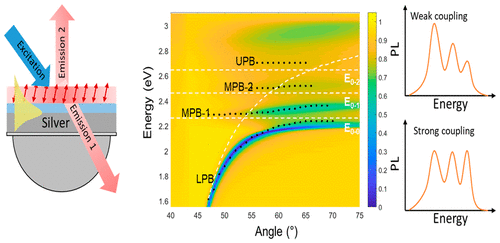当前位置:
X-MOL 学术
›
ACS Photonics
›
论文详情
Our official English website, www.x-mol.net, welcomes your
feedback! (Note: you will need to create a separate account there.)
Modifying the Spectral Weights of Vibronic Transitions via Strong Coupling to Surface Plasmons
ACS Photonics ( IF 6.5 ) Pub Date : 2020-01-02 , DOI: 10.1021/acsphotonics.9b01357 Rahul Deshmukh 1, 2 , Paulo Marques , Anurag Panda 3 , Matthew Y. Sfeir 2, 4 , Stephen R. Forrest 3, 5 , Vinod M. Menon 1, 2
ACS Photonics ( IF 6.5 ) Pub Date : 2020-01-02 , DOI: 10.1021/acsphotonics.9b01357 Rahul Deshmukh 1, 2 , Paulo Marques , Anurag Panda 3 , Matthew Y. Sfeir 2, 4 , Stephen R. Forrest 3, 5 , Vinod M. Menon 1, 2
Affiliation

|
Strong light–matter coupling results in the formation of hybrid half-light half-matter excitations with modified energy levels. The strong coupling of excitons with photons in organic molecular systems has received much attention recently owing to the potential for engineering their photophysical properties and even the prospects for controlling chemical reactions. One means to affect chemical reactions is to control the molecular excited states within their vibronic manifolds. Here we demonstrate the modification of the spectral weight of the vibronic transitions and excimer emission in an archetype organic molecule, diindenoperylene (DIP), by strong coupling to surface-plasmon polaritons. The vertically aligned DIP molecule is grown on an ultrasmooth film of Ag with a 3 nm thick alumina spacer. Through angle-resolved reflectivity measurements we demonstrate the strong coupling between the surface-plasmon mode of the Ag and the vibronic transitions in DIP. Temperature-dependent photoluminescence measurements show the shift in the spectral weight of the emission peaks when the molecules are in the strong coupling regime—changes that are attributed to the polaritonic control of the oscillator strengths of emissive states owing to modification in the Franck–Condon factor and efficient energy transfer to lower-lying excimer states. This work demonstrates the potential to modify the material properties through a strong light–matter interaction.
中文翻译:

通过与表面等离激元的强耦合来改变电子跃迁的谱权重
强大的光-质耦合导致形成混合半光/半光激发,其能量水平发生了变化。激子与光子在有机分子系统中的强耦合最近由于其工程化其光物理性质的潜力甚至控制化学反应的前景而备受关注。影响化学反应的一种方法是控制其电子歧管内的分子激发态。在这里,我们证明了原型有机分子二茚并oper烯(DIP)通过与表面等离激元极化子的强耦合而改变了电子振动跃迁和准分子发射光谱的光谱重量。垂直排列的DIP分子在具有3 nm厚氧化铝间隔层的Ag超光滑膜上生长。通过角度分辨反射率测量,我们证明了Ag的表面等离激元模式与DIP中的电子跃迁之间的强耦合。与温度相关的光致发光测量结果显示,当分子处于强耦合状态时,发射峰的光谱权重发生了变化,这归因于Franck-Condon因子的修饰,对发射态的振荡器强度进行了极化控制。高效地将能量转移到较低的准分子状态。这项工作证明了通过强烈的光-物质相互作用来改变材料特性的潜力。与温度相关的光致发光测量结果显示,当分子处于强耦合状态时,发射峰的光谱权重发生了变化,这归因于Franck-Condon因子的修饰,对发射态的振荡器强度进行了极化控制。高效地将能量转移到较低的准分子状态。这项工作证明了通过强烈的光-物质相互作用来改变材料特性的潜力。与温度相关的光致发光测量结果显示,当分子处于强耦合状态时,发射峰的光谱权重发生了变化,这归因于Franck-Condon因子的修饰,对发射态的振荡器强度进行了极化控制。高效地将能量转移到较低的准分子状态。这项工作证明了通过强烈的光-物质相互作用来改变材料特性的潜力。
更新日期:2020-01-02
中文翻译:

通过与表面等离激元的强耦合来改变电子跃迁的谱权重
强大的光-质耦合导致形成混合半光/半光激发,其能量水平发生了变化。激子与光子在有机分子系统中的强耦合最近由于其工程化其光物理性质的潜力甚至控制化学反应的前景而备受关注。影响化学反应的一种方法是控制其电子歧管内的分子激发态。在这里,我们证明了原型有机分子二茚并oper烯(DIP)通过与表面等离激元极化子的强耦合而改变了电子振动跃迁和准分子发射光谱的光谱重量。垂直排列的DIP分子在具有3 nm厚氧化铝间隔层的Ag超光滑膜上生长。通过角度分辨反射率测量,我们证明了Ag的表面等离激元模式与DIP中的电子跃迁之间的强耦合。与温度相关的光致发光测量结果显示,当分子处于强耦合状态时,发射峰的光谱权重发生了变化,这归因于Franck-Condon因子的修饰,对发射态的振荡器强度进行了极化控制。高效地将能量转移到较低的准分子状态。这项工作证明了通过强烈的光-物质相互作用来改变材料特性的潜力。与温度相关的光致发光测量结果显示,当分子处于强耦合状态时,发射峰的光谱权重发生了变化,这归因于Franck-Condon因子的修饰,对发射态的振荡器强度进行了极化控制。高效地将能量转移到较低的准分子状态。这项工作证明了通过强烈的光-物质相互作用来改变材料特性的潜力。与温度相关的光致发光测量结果显示,当分子处于强耦合状态时,发射峰的光谱权重发生了变化,这归因于Franck-Condon因子的修饰,对发射态的振荡器强度进行了极化控制。高效地将能量转移到较低的准分子状态。这项工作证明了通过强烈的光-物质相互作用来改变材料特性的潜力。











































 京公网安备 11010802027423号
京公网安备 11010802027423号